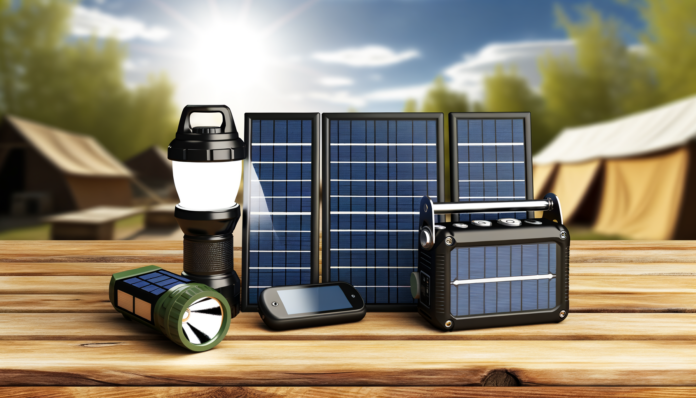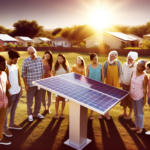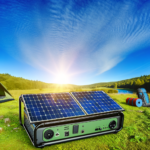Introduction to Solar-Powered Gear for Emergency Kits
Importance of Solar Power in Emergencies
In recent years, the frequency and severity of natural disasters have increased, leading to a significant rise in power outages. In 2020 alone, utility company customers in the US experienced 1.33 billion power outages, a 73% increase from the previous year. During such emergencies, having a reliable backup power source is crucial. Solar power stands out as an ideal solution because it harnesses energy from the sun, which is a free and abundant resource. Unlike traditional gas generators, solar power systems do not produce harmful emissions or noise, making them environmentally friendly and safe for indoor use.
Benefits of Solar-Powered Gear
Solar-powered gear offers numerous advantages, especially in emergency situations:
- Reliability: Solar power systems can operate independently of the grid, providing a consistent power source even during extended outages.
- Environmental Impact: Solar energy is clean and renewable, reducing the carbon footprint compared to fossil fuel-based generators.
- Low Maintenance: Solar-powered devices require minimal upkeep, as they do not have moving parts that can wear out over time.
- Portability: Many solar-powered devices are designed to be portable, making them easy to transport and use in various locations.
- Cost-Effective: After the initial investment, solar power is free, eliminating the need for ongoing fuel purchases.
Overview of Essential Solar-Powered Items
When assembling an emergency kit, incorporating solar-powered gear can significantly enhance your preparedness. Here are some essential solar-powered items to consider:
- Solar Lanterns: These provide reliable lighting without the need for batteries or fuel, making them perfect for extended power outages.
- Solar Flashlights: Compact and efficient, solar flashlights are ideal for navigating in the dark during emergencies.
- Solar String Lights: Useful for illuminating larger areas, solar string lights can create a safe and well-lit environment.
- Solar-Powered Radios: Stay informed about weather updates and emergency broadcasts with a solar-powered radio.
- Solar-Powered Satellite Phones: Ensure you can communicate with emergency services and loved ones even when traditional networks are down.
- Solar-Powered Walkie-Talkies: These are excellent for short-range communication, especially in group settings.
- Portable Solar Chargers: Keep your essential devices charged with portable solar chargers, which are compact and easy to use.
- Solar Power Banks: Store solar energy for later use, ensuring you have a backup power source for your devices.
- Solar Generators: These versatile units can power multiple devices and appliances, making them invaluable during prolonged outages.
- Solar Ovens: Cook food without relying on gas or electricity, a crucial feature during extended emergencies.
- Solar Water Heaters: Provide hot water for hygiene and cooking needs, enhancing comfort during crises.
- Solar-Powered Stoves: These stoves offer a reliable cooking solution without the need for traditional fuels.
Incorporating these solar-powered items into your emergency kit ensures that you are well-prepared to handle power outages and other emergencies efficiently and sustainably.
Solar-Powered Lighting Solutions
In any emergency situation, having a reliable source of light is crucial. Solar-powered lighting solutions offer an excellent alternative to traditional battery-operated or electrical lights, ensuring you have illumination when you need it most. Below, we explore three essential types of solar-powered lighting: solar lanterns, solar flashlights, and solar string lights.
Solar Lanterns
Solar lanterns are versatile and efficient, making them a must-have for any emergency kit. These lanterns harness the sun’s energy during the day and store it in built-in batteries, providing hours of light when the sun goes down. They are perfect for illuminating larger areas, such as a room or a campsite.
**Benefits of Solar Lanterns:**
– **Portability:** Most solar lanterns are lightweight and easy to carry, making them ideal for both indoor and outdoor use.
– **Durability:** Designed to withstand harsh conditions, many solar lanterns are water-resistant and built to last.
– **Multi-functionality:** Some models come with additional features like USB ports for charging devices, making them even more valuable in an emergency.
Solar Flashlights
Solar flashlights are another essential item for your emergency kit. These compact and powerful devices are perfect for focused lighting needs, such as navigating in the dark or signaling for help. Like solar lanterns, they charge during the day and provide reliable light at night.
**Advantages of Solar Flashlights:**
– **Compact Size:** Easy to store and carry, solar flashlights can fit in your pocket or emergency bag.
– **Long Battery Life:** Many models offer extended battery life, ensuring you have light when you need it most.
– **Eco-Friendly:** By using solar energy, these flashlights reduce the need for disposable batteries, making them an environmentally friendly option.
Solar String Lights
Solar string lights are not just for decoration; they can be a practical addition to your emergency lighting solutions. These lights are perfect for illuminating larger outdoor areas, such as a backyard or a campsite, and can also be used indoors.
**Key Features of Solar String Lights:**
– **Versatility:** Solar string lights can be hung almost anywhere, providing flexible lighting options.
– **Energy Efficiency:** They use minimal energy while providing ample light, making them an efficient choice.
– **Aesthetic Appeal:** In addition to their practical uses, solar string lights can create a pleasant ambiance, which can be comforting during stressful situations.
In conclusion, incorporating solar-powered lighting solutions into your emergency kit ensures you have reliable, eco-friendly, and efficient sources of light when you need them most. Whether you choose solar lanterns, flashlights, or string lights, these devices will help you stay prepared and safe in any emergency.
Solar-Powered Communication Devices
In an emergency, staying connected with the outside world is crucial. Solar-powered communication devices ensure that you can maintain contact even when traditional power sources are unavailable. Here, we explore three essential solar-powered communication devices: radios, satellite phones, and walkie-talkies.
Solar-Powered Radios
Solar-powered radios are indispensable in emergency situations. They provide access to critical information such as weather updates, news, and emergency broadcasts. Unlike traditional radios, solar-powered versions do not rely on batteries or electrical outlets, making them highly reliable during power outages.
**Key Features:**
– **Multiple Power Sources:** Many solar radios, like the Scorpion II Multi-Powered Weather Radio & Flashlight by Eton, come with multiple power options including solar panels, hand cranks, and USB charging.
– **Additional Functions:** These radios often include built-in flashlights, USB chargers, and even SOS alarms, making them versatile tools in an emergency kit.
– **Durability:** Designed to withstand harsh conditions, these radios are typically rugged and water-resistant.
**Benefits:**
– **Continuous Operation:** As long as there is sunlight, these radios can keep you informed without the need for external power sources.
– **Multi-functionality:** The added features such as flashlights and USB charging ports make them more than just radios, providing multiple utilities in one device.
Solar-Powered Satellite Phones
When traditional communication networks fail, satellite phones become indispensable. Solar-powered satellite phones ensure that you can stay connected even in the most remote areas or during severe disasters.
**Key Features:**
– **Global Coverage:** Satellite phones like the Iridium 9575 Extreme and Inmarsat IsatPhone 2 offer global coverage, ensuring you can make calls from virtually anywhere on the planet.
– **Durability:** These phones are built to withstand extreme conditions, including water, dust, and shock.
– **Long Battery Life:** Solar charging capabilities extend the battery life, making them reliable for extended use during emergencies.
**Benefits:**
– **Reliable Communication:** Satellite phones provide a reliable means of communication when cell towers are down or non-existent.
– **Emergency Features:** Many models come with GPS tracking and SOS buttons, which can be lifesaving in critical situations.
Solar-Powered Walkie-Talkies
Walkie-talkies are essential for short-range communication, especially in scenarios where immediate, direct communication is necessary. Solar-powered walkie-talkies ensure that you can maintain this vital link without worrying about battery life.
**Key Features:**
– **Rechargeable Batteries:** These walkie-talkies come with rechargeable batteries that can be powered by solar panels, ensuring they are always ready for use.
– **Long Range:** High-quality models offer long-range communication, making them suitable for various emergency scenarios.
– **Durability:** Built to be rugged and water-resistant, these devices can withstand tough conditions.
**Benefits:**
– **Instant Communication:** Walkie-talkies provide instant communication, which is crucial for coordinating rescue efforts or staying in touch with family members.
– **No Need for Network:** Unlike cell phones, walkie-talkies do not rely on network coverage, making them reliable in remote areas.
In conclusion, solar-powered communication devices are essential components of any emergency kit. They ensure that you can stay informed, connected, and safe, regardless of the situation. Investing in solar-powered radios, satellite phones, and walkie-talkies can provide peace of mind and a reliable means of communication when you need it most.
Solar-Powered Charging Solutions
In an emergency, keeping your devices charged can be a matter of life and death. Solar-powered charging solutions offer a reliable and eco-friendly way to ensure that your essential gadgets remain operational when traditional power sources are unavailable. Here, we explore three key types of solar-powered charging solutions: portable solar chargers, solar power banks, and solar generators.
Portable Solar Chargers
Portable solar chargers are compact, lightweight, and designed for on-the-go use. These devices typically consist of foldable solar panels that can be easily packed into a backpack or emergency kit. When unfolded and exposed to sunlight, they convert solar energy into electrical power, which can be used to charge small devices like smartphones, GPS units, and cameras.
**Benefits of Portable Solar Chargers:**
– **Portability:** Their lightweight and foldable design make them easy to carry.
– **Versatility:** Suitable for a variety of small electronic devices.
– **Eco-Friendly:** Utilize renewable solar energy, reducing reliance on disposable batteries.
**Popular Models:**
– **Goal Zero Nomad 7 Plus:** Known for its durability and efficiency, this model is perfect for outdoor enthusiasts and emergency preparedness.
– **Anker PowerPort Solar Lite:** Offers a balance of affordability and performance, making it a popular choice for budget-conscious users.
Solar Power Banks
Solar power banks combine the functionality of a traditional power bank with the added benefit of solar charging. These devices store electrical energy in built-in batteries, which can then be used to charge your devices even when the sun isn’t shining. Solar power banks are ideal for extended emergencies where consistent access to sunlight may not be guaranteed.
**Benefits of Solar Power Banks:**
– **Storage Capacity:** Can store energy for use during nighttime or cloudy days.
– **Multiple Outputs:** Often feature multiple USB ports to charge several devices simultaneously.
– **Durability:** Many models are designed to withstand harsh conditions, making them suitable for emergency scenarios.
**Popular Models:**
– **RAVPower Solar Power Bank:** Offers a high-capacity battery and multiple charging ports, making it a versatile option for various devices.
– **Halo Bolt Solar Charger:** Not only charges small devices but also includes jumper cables to start your car, adding an extra layer of utility.
Solar Generators
Solar generators are the heavyweights of solar-powered charging solutions. These devices are equipped with large battery packs and multiple outlets, capable of powering larger electronics and even small appliances. Solar generators are ideal for prolonged power outages or off-grid living situations.
**Benefits of Solar Generators:**
– **High Capacity:** Can power larger devices like laptops, medical equipment, and even small refrigerators.
– **Multiple Outlets:** Provide various types of outlets, including AC, DC, and USB, to accommodate different devices.
– **Eco-Friendly:** Operate without fuel, reducing environmental impact and eliminating the need for fuel storage.
**Popular Models:**
– **Goal Zero Yeti 6000X:** Known for its massive capacity and robust build, this model can power a home for days in case of a disaster.
– **Bluetti EB70:** Offers a balance of capacity and portability, making it suitable for both home use and outdoor adventures.
Incorporating these solar-powered charging solutions into your emergency kit ensures that you can stay connected and powered up, no matter the situation. Whether you need to charge a phone, power a medical device, or keep your home running during a blackout, these solar-powered options provide reliable and sustainable energy solutions.
Solar-Powered Cooking and Heating
Solar Ovens
Solar ovens are an innovative and eco-friendly solution for cooking during emergencies. These devices harness the sun’s energy to cook food, eliminating the need for traditional fuels like gas or electricity. Solar ovens come in various designs, including box cookers, panel cookers, and parabolic cookers, each with its unique advantages.
**Box cookers** are insulated containers with a transparent lid that allows sunlight to enter and heat the interior. They are versatile and can cook a variety of foods, from baking bread to roasting meats. **Panel cookers** use reflective panels to direct sunlight onto a cooking pot, making them lightweight and portable. **Parabolic cookers** focus sunlight onto a single point, achieving higher temperatures suitable for frying and grilling.
Using a solar oven is straightforward: place your food inside, position the oven to face the sun, and let the solar energy do the work. Solar ovens are not only useful in emergencies but also for outdoor activities like camping and picnics.
Solar Water Heaters
Access to hot water is crucial for hygiene and cooking, especially during emergencies. Solar water heaters provide a reliable and sustainable way to heat water using the sun’s energy. These systems typically consist of solar collectors, a storage tank, and a circulation system.
**Solar collectors** absorb sunlight and convert it into heat, which is then transferred to the water in the storage tank. There are two main types of solar collectors: **flat-plate collectors** and **evacuated tube collectors**. Flat-plate collectors are more common and consist of a dark absorber plate under a transparent cover. Evacuated tube collectors are more efficient and consist of multiple glass tubes, each containing a heat-absorbing material.
Solar water heaters can be passive or active systems. **Passive systems** rely on natural convection to circulate water, making them simpler and more reliable. **Active systems** use pumps to circulate water, offering better performance but requiring more maintenance.
Solar-Powered Stoves
Solar-powered stoves are another excellent addition to your emergency kit. These stoves use solar panels to generate electricity, which powers an electric heating element. Unlike solar ovens, solar-powered stoves can be used indoors and provide more consistent cooking temperatures.
**Portable solar stoves** are compact and easy to transport, making them ideal for emergency situations and outdoor activities. They often come with built-in solar panels or can be connected to external solar panels for more power. Some models also include USB ports for charging devices, adding to their versatility.
Using a solar-powered stove is simple: set up the solar panels to capture sunlight, connect them to the stove, and start cooking. These stoves are perfect for boiling water, frying, and simmering, providing a reliable cooking solution when traditional power sources are unavailable.
In conclusion, incorporating solar-powered cooking and heating solutions into your emergency kit ensures you can prepare meals and maintain hygiene even during power outages. Solar ovens, solar water heaters, and solar-powered stoves offer sustainable and efficient alternatives to traditional cooking methods, making them essential components of any well-prepared emergency kit.
Maintenance and Care for Solar-Powered Gear
Proper Storage
Proper storage of your solar-powered gear is crucial to ensure its longevity and functionality during emergencies. Here are some key tips for storing your equipment:
- Dry Environment: Store your gear in a dry, cool place to prevent moisture damage and battery degradation. Avoid areas prone to flooding or high humidity.
- Organized Storage: Keep your solar-powered items organized in a dedicated emergency kit or storage box. This makes it easier to locate and access them quickly when needed.
- Temperature Control: Extreme temperatures can affect the performance and lifespan of solar-powered devices. Store them in a temperature-controlled environment, ideally between 50°F and 77°F (10°C and 25°C).
- Protective Cases: Use protective cases or pouches to shield your gear from dust, dirt, and physical damage. This is especially important for delicate items like solar panels and electronic devices.
Regular Cleaning
Regular cleaning of your solar-powered gear ensures optimal performance and extends its lifespan. Follow these steps to keep your equipment in top condition:
- Solar Panels: Clean the surface of solar panels with a soft cloth and mild soapy water. Avoid abrasive materials that can scratch the surface. Rinse with clean water and dry thoroughly.
- Electronic Devices: Wipe down electronic devices, such as solar-powered radios and flashlights, with a damp cloth. Ensure that no water enters the device, especially around buttons and ports.
- Battery Contacts: Check and clean battery contacts regularly to prevent corrosion. Use a cotton swab dipped in rubbing alcohol to clean the contacts gently.
- Inspect for Damage: Regularly inspect your gear for any signs of wear and tear, such as cracks, frayed wires, or loose connections. Address any issues promptly to prevent further damage.
Battery Maintenance
Proper battery maintenance is essential for the reliability and efficiency of your solar-powered gear. Here are some tips to keep your batteries in good condition:
- Charge Regularly: Even if not in use, charge your solar-powered devices periodically to keep the batteries active. This helps prevent battery degradation and ensures they are ready for use in an emergency.
- Avoid Overcharging: Overcharging can damage batteries and reduce their lifespan. Use devices with built-in overcharge protection or monitor the charging process to prevent overcharging.
- Store at Partial Charge: If storing for an extended period, keep batteries at a partial charge (around 50-70%). Fully charged or completely drained batteries can degrade faster over time.
- Replace When Necessary: Batteries have a limited lifespan and will eventually need replacement. Keep spare batteries on hand and replace old ones as needed to ensure your gear remains functional.
By following these maintenance and care tips, you can ensure that your solar-powered gear remains reliable and effective during emergencies. Proper storage, regular cleaning, and diligent battery maintenance will help you get the most out of your investment and be prepared for any situation.
Conclusion and Final Tips
Recap of Essential Gear
In the face of emergencies, having a well-prepared kit with solar-powered gear can make a significant difference. Here’s a quick recap of the essential solar-powered items you should consider for your emergency kit:
- Solar Lanterns: Provide reliable lighting without the need for batteries or electricity.
- Solar Flashlights: Compact and efficient, perfect for navigating in the dark.
- Solar String Lights: Useful for illuminating larger areas and creating a safe environment.
- Solar-Powered Radios: Keep you informed with news and weather updates.
- Solar-Powered Satellite Phones: Ensure communication when traditional networks fail.
- Solar-Powered Walkie-Talkies: Ideal for short-range communication.
- Portable Solar Chargers: Charge small devices like phones and tablets.
- Solar Power Banks: Store energy to charge multiple devices over time.
- Solar Generators: Provide substantial power for larger appliances and extended use.
- Solar Ovens: Cook food using only sunlight, essential for long-term emergencies.
- Solar Water Heaters: Ensure access to hot water without relying on the grid.
- Solar-Powered Stoves: Cook meals efficiently using solar energy.
Tips for Maximizing Efficiency
To get the most out of your solar-powered gear, consider the following tips:
- Optimize Sunlight Exposure: Place solar panels and devices in direct sunlight for maximum efficiency. Avoid shaded areas and adjust the angle to capture the most sunlight throughout the day.
- Regular Maintenance: Keep your solar panels clean and free from dust and debris. Regularly check connections and ensure that all components are in good working order.
- Energy Management: Prioritize the use of solar power for essential devices first. Use energy-efficient appliances and LED lights to extend the battery life of your solar power systems.
- Battery Care: Follow manufacturer guidelines for charging and discharging batteries. Avoid overcharging and deep discharging to prolong battery life.
- Backup Options: Have multiple solar-powered devices and backup batteries to ensure you have power when you need it most.
Staying Updated with Solar Technology
Solar technology is continually evolving, offering more efficient and powerful solutions. To stay updated:
- Research and Reviews: Regularly read reviews and research new products to find the best options for your needs.
- Join Communities: Participate in online forums and communities focused on solar technology and emergency preparedness. These platforms can provide valuable insights and recommendations.
- Manufacturer Updates: Subscribe to newsletters from reputable solar gear manufacturers to receive updates on new products and advancements.
- Training and Workshops: Attend workshops and training sessions to learn more about the latest solar technologies and how to use them effectively.
By incorporating these essential solar-powered items into your emergency kit and following these tips, you can ensure that you are well-prepared for any situation. Solar power offers a reliable, sustainable, and eco-friendly solution to keep you and your loved ones safe during emergencies. Stay informed, stay prepared, and harness the power of the sun to navigate through challenging times.






